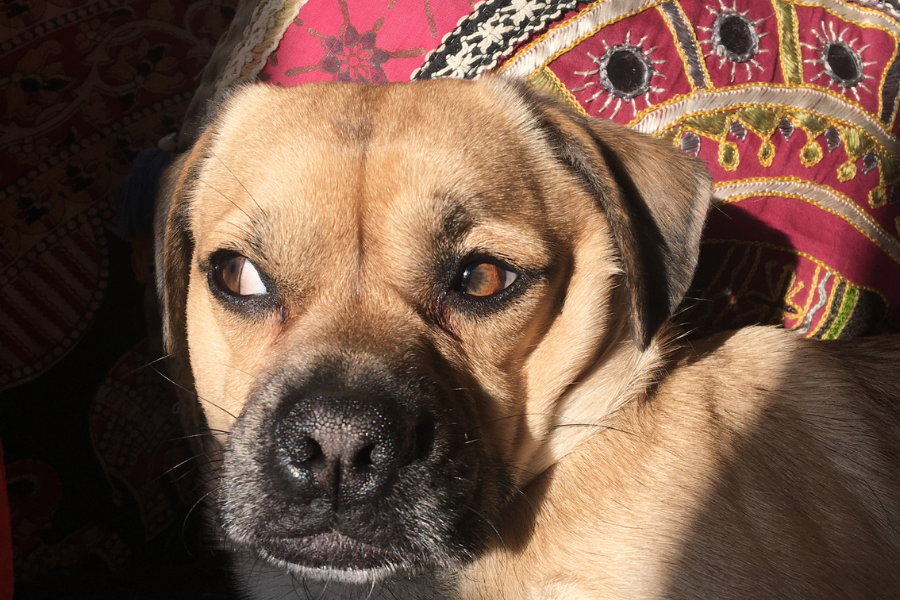Introduction
It's cute, but mysterious to many of us - the side eye look from your dog. If you've ever been chillin' with your pup and all of a sudden get the look, and wonder to yourself "what the heck are they trying to tell me!?", you're in the right place. The dog side is one of many ways dogs use their bodies to communicate and express themselves. In this blog, we will dig into the science of dog body language, the possible meanings behind the side eye, and hopefully help you understand your dog even better than you already do.
What is Dog Side Eye?
So what is dog side eye, anyway? Dog side eye is exactly as what it sounds like - it's when a dog (like a human can do) turns their head slightly away but keeps their eyes fixed on something, making the whites of their eyes visible. The look is humorous, no doubt, and seems like a human expression, but it's also perplexing. What is a dog trying to communicate if they give you this look?
The Anatomy of Side Eye
You may think that dogs and humans have the same eye-anatomy, but think again! Dogs have a much wider field of vision than humans do, which allows them to see more peripherally. And when they do the side eye, they are using they are using this peripheral vision to some extent. Dogs also do not see the same spectrum of colors that humans do.
Common Situations for Side Eye
Most dog owners (us included) will notice their dog do the side eye in very specific instances. These situations, and their commonalities will give you insight into what your dog is feeling. For instance, when your dog is feeling uneasy, threatened, or even playful, they might give you or another dog the side eye. These contexts can be the first steps in helping you decode your dog’s expressions.
The Emotional Spectrum
While it would make for a much more simplified and shortened blog, the side eye is not attributed to just one emotion. It can be signal of several emotions, from curiosity to severe anxiety. Understanding this range of emotions associated with the look can help you respond appropriately!
Communicating Discomfort or Anxiety
Anxiety and/or discomfort can be a main reason a dog gives the side eye. They simply could be trying to communicate “I am uncomfortable!”
Signs of Discomfort
Along with the side eye, you might notice other signs of discomfort such as a tucked tail, raised hackles, or a low growl. These combined signals can give you a clearer picture of your dog’s emotional state.
Responding to Anxiety
If your dog is showing signs of anxiety, it's important to address the root cause. Whether it's a new environment, an unfamiliar person, or another animal, identifying and mitigating these stressors can help your dog feel more secure.
Building Trust and Security
Building trust with your dog is key. Positive reinforcement, consistent routines, and a safe environment can significantly reduce anxiety-related behaviors, including the side eye.
Expressing Curiosity or Alertness
Alright, we know the expressions associated with a dog side eye look so far have been negative. Now let’s look at some of the potential positive expressions associated with the side eye look, like alertness, interest in something, or curiosity!
Detecting Curiosity
When dogs are curious, their body language is usually relaxed. The side eye might be accompanied by a wagging tail, perked ears, or a slight tilt of the head.
Encouraging Exploration
Encouraging your dog to explore their environment safely can satisfy their curiosity. Providing toys, interactive games, and new experiences can keep their minds stimulated and happy.
The Role of Enrichment
Enrichment activities are essential for a dog's mental and emotional well-being. Puzzle toys, agility training, and scent work can channel their curiosity positively and reduce the occurrence of anxious side eye.
Showing Playfulness
Yes, dogs can even pull out the side eye during play! It could be their way of communicating that they are, well, feeling playful – with other dogs or humans.
Playful Cues
You probably know your dog’s playful cues by now. Bowing, wagging, jumping around (our dog actually bops us on the leg with her nose when she wants to play) are all playful cues that mean your dog wants you (or another dog) to play with them!
Safe Play Practices
Ensuring play is safe is crucial. Supervise interactions, especially with new dogs, and provide appropriate toys to prevent any accidental injuries or misunderstandings.
Strengthening Bonds Through Play
Playtime is not just about fun; it’s also an opportunity to strengthen the bond between you and your dog. Positive interactions during play build trust and mutual understanding.
Seeking Attention
If your dog is anything like our dog, they want attention – and like, all the attention, all the time. So, if your dog climbs up next to you on the couch, puts their back against you, leans over and gives you a side eye, they are most likely just wanting your attention, and some scratches. Whether they want food, a walk, or just some affection, this look can be their subtle way of asking for it.
Recognizing Attention-Seeking Behavior
Attention-seeking side eye is often accompanied by other behaviors like pawing, whining, or nudging. These signals are your dog’s way of communicating their needs.
Meeting Their Needs
Responding to your dog's needs promptly can reinforce positive behavior. Make sure they have regular feeding times, exercise, and plenty of affection.
Avoiding Negative Reinforcement
On the flip side, you also should be mindful not to reinforce negative behaviors accidentally. If your dog is seeking attention inappropriately, like barking or jumping, teach them alternative ways to ask for what they need.
Establishing Boundaries
Dogs also use the side eye to establish boundaries, especially when they feel their personal space is being invaded.
Respecting Their Space
Just like humans, dogs need personal space. Respecting their boundaries and giving them time to adjust can prevent stress and build a trusting relationship.
Training and Boundaries
Training your dog to understand commands like “leave it” or “stay” can help manage situations where they feel their space is threatened.
Creating a Safe Space
Providing your dog with a designated safe space, like a crate or a specific room, can give them a retreat where they can feel secure and relaxed.
The Role of Socialization
Socialization plays a significant role in how dogs communicate, including their use of side eye. Proper socialization can reduce anxiety and improve their interactions with others.
Early Socialization
Introducing puppies to a variety of people, animals, and environments at a young age can help them develop into well-adjusted adults. This can minimize fear-based side eye as they grow.
Ongoing Socialization
Socialization shouldn’t stop after puppyhood. Regular exposure to new experiences and positive interactions can maintain your dog’s confidence and reduce anxiety.
Professional Socialization Classes
Consider enrolling your dog in socialization classes or working with a professional trainer to address any specific behavioral issues. This can provide structured opportunities for positive experiences.
Reading the Entire Body Language
To fully understand the side eye, it’s essential to read your dog’s entire body language. This holistic approach gives a more accurate picture of their emotional state.
Combining Signals
Look for a combination of signals such as ear position, tail movement, and body posture along with the side eye to decode their message accurately.
Context Matters
Always consider the context in which the side eye occurs. Different situations can evoke different reactions, and understanding the context can help you respond appropriately.
Continuous Learning
Learning to read your dog’s body language is an ongoing process. Spend time observing and interacting with your dog to become more attuned to their signals.
When to Seek Professional Help
If the side eye behavior is associated with other problematic behaviors, it could be time to call the pros – and by pros we mean your veterinarian, or a trainer. Chronic and severe aggressive, reactive, or anxiety-related behavior should be addressed sooner rather than later.
Identifying Red Flags
Red flags include aggression, persistent fear, or unexplained changes in behavior. These signs indicate that your dog may need professional intervention.
Consulting a Veterinarian
A veterinarian can rule out any medical issues that might be contributing to your dog’s behavior. Health problems sometimes manifest as behavioral changes.
Working with a Trainer
There are a ton of well-qualified dog trainers and behaviorists out there. These professionals can give you and your dog a tailored game plan to tackle specific issues you’re facing.
Conclusion
Simply put, understanding your dog's looks and body language allow you to be a better dog parent. When you're able to quickly decode a side eye look, or any other signal your dog is giving you (either positive or negative), you can respond quickly to their needs, and make sure they continually feel loved, safe and secure.
Well, we hope this blog answered all of your dog side eye-questions, and at a minimum encourages you to observe your dog's behaviors more. And if you ever need to eye this blog over (pun intended) in the future, be sure to favorite this page!
References
1) Kis A, Hernádi A, Miklósi B, Kanizsár O, Topál J. The Way Dogs (Canis familiaris) Look at Human Emotional Faces Is Modulated by Oxytocin. An Eye-Tracking Study. Front Behav Neurosci. 2017 Oct 31;11:210. doi: 10.3389/fnbeh.2017.00210. PMID: 29163082; PMCID: PMC5671652.



